

BBC - The horrors of the 17th Century witch hunts. A 17th Century woodcut showing three witches and their familiars For two years in the mid-1640s, terrifying witch hunts were unleashed on a population already reeling from the first English Civil War.
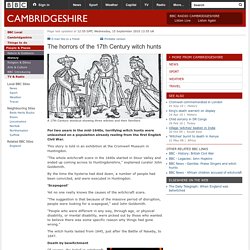
This story is told in an exhibition at the Cromwell Museum in Huntingdon. "The whole witchcraft scare in the 1640s started in Stour Valley and ended up coming across to Huntingdonshire," explained curator John Goldsmith. By the time the hysteria had died down, a number of people had been convicted, and were executed in Huntingdon. 'Scapegoat' Yet no one really knows the causes of the witchcraft scare. "The suggestion is that because of the massive period of disruption, people were looking for a scapegoat," said John Goldsmith. BBC Bitesize - KS3 English Literature - Beliefs and superstitions - Revision 2. Witchcraft in Tudor Times. British attitudes to witchcraft during the Tudor era tended to be less extreme than those of contemporary Europeans.

Indeed, under the right circumstances, the British witch could occasionally become an acceptable – if not quite respectable – member of society. This produced characters such as the village elder with healing skills, usually burnt at the stake in places like Denmark or Germany, and the eccentric gentleman with a library of arcane tomes whose ‘experiments’ were considered scientific rather than supernatural. Acceptance was not universal, however, and those who attracted the attention of the witchfinder – or even the Inquisition under Mary I’s reign – often ended up on trial for their lives. Happily, many of these ‘witches’ escaped conviction, since most English tests tended to favour the accused. Tudortube. Tudor Food. Tudor Market Place. Tudor Entertainment (1) Tudor Costume. What did people in the Tudor period eat? History Extra explains... As part of our 'History Extra explains' series, leading historians answer the burning questions you were too afraid to ask...

Tuesday 7th April 2015 Submitted by: Emma Mason A selection of 16th-century foods at Little Moreton Hall. © christopher jones / Alamy Rank, station, and even religious customs affected what you ate throughout the Tudor period. Meat was forbidden on a Friday, when people ate fish instead. Tudor dining: a guide to food and status in the 16th century. In Tudor England, maintaining the difference between ranks was so important to the concept of a well-ordered society that efforts were made to enshrine the distinctions between the classes in ‘sumptuary’ laws.

These laws tried to control what you ate and wore, according to your position in the God-given hierarchy, which stretched from the king at the top, down through the numerous grades of nobility and clergy, to the gentry, yeomen and finally the labourers at the bottom of the heap. Of course, for the poorest, sumptuary laws were not terribly relevant. Labourers would not often be able to afford more than pottage – the staple dish – and you could eat as much of that as your budget would allow. The rich ate pottage too, but instead of what was basically cabbage soup with some barley or oats – and a sniff of bacon if you were lucky – a nobleman’s pottage might contain almonds, ginger and saffron, as well as wine. Four seasons Seasonality was a major factor in 16th-century diets. A Tudor Christmas. Long before the birth of Christ, midwinter had always been a time for merry making by the masses.
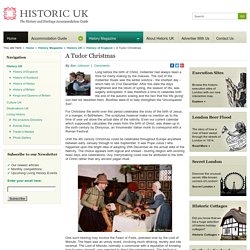
: Elizabethan Superstitions. Ignorance and fear of the unknown combined with a false conception of causation and cessation resulted in many Elizabethan superstitions.
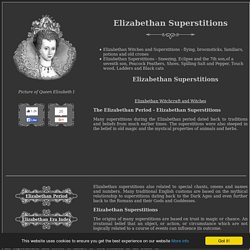
Fear and Superstition. The early seventeenth century, when the witch hunts were at their height, was dominated by fear and superstition.
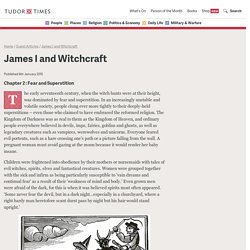
In an increasingly unstable and volatile society, people clung ever more tightly to their deeply-held superstitions – even those who claimed to have embraced the reformed religion. The Kingdom of Darkness was as real to them as the Kingdom of Heaven, and ordinary people everywhere believed in devils, imps, fairies, goblins and ghosts, as well as legendary creatures such as vampires, werewolves and unicorns. Everyone feared evil portents, such as a hare crossing one's path or a picture falling from the wall.
A pregnant woman must avoid gazing at the moon because it would render her baby insane. Children were frightened into obedience by their mothers or nursemaids with tales of evil witches, spirits, elves and fantastical creatures. There was thus a fertile ground for James's witch hunting beliefs to take hold. Was Halloween Started by the Tudors? - Tudors Dynasty. History of Halloween Over 2,000 years ago the Celts celebrated summer’s end, or Samhain (pronounced /ˈsɑːwɪn/ SAH-win) on the 1st of November which marked the end of harvest and the beginning of winter.
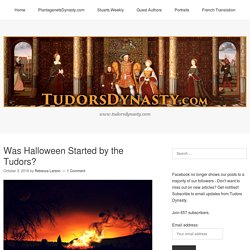
The night before Samhain, people believed the dead returned as ghosts. By leaving food and wine on their doorstep they would keep the ghosts away – they also dressed in disguise to blend in with the ghosts who walked among them. The Christian Church turned Samhain into All Saints Day and in the 8th century All Saints Day became known as All Hallows. That was when October 31st became All Hallow’s Eve.